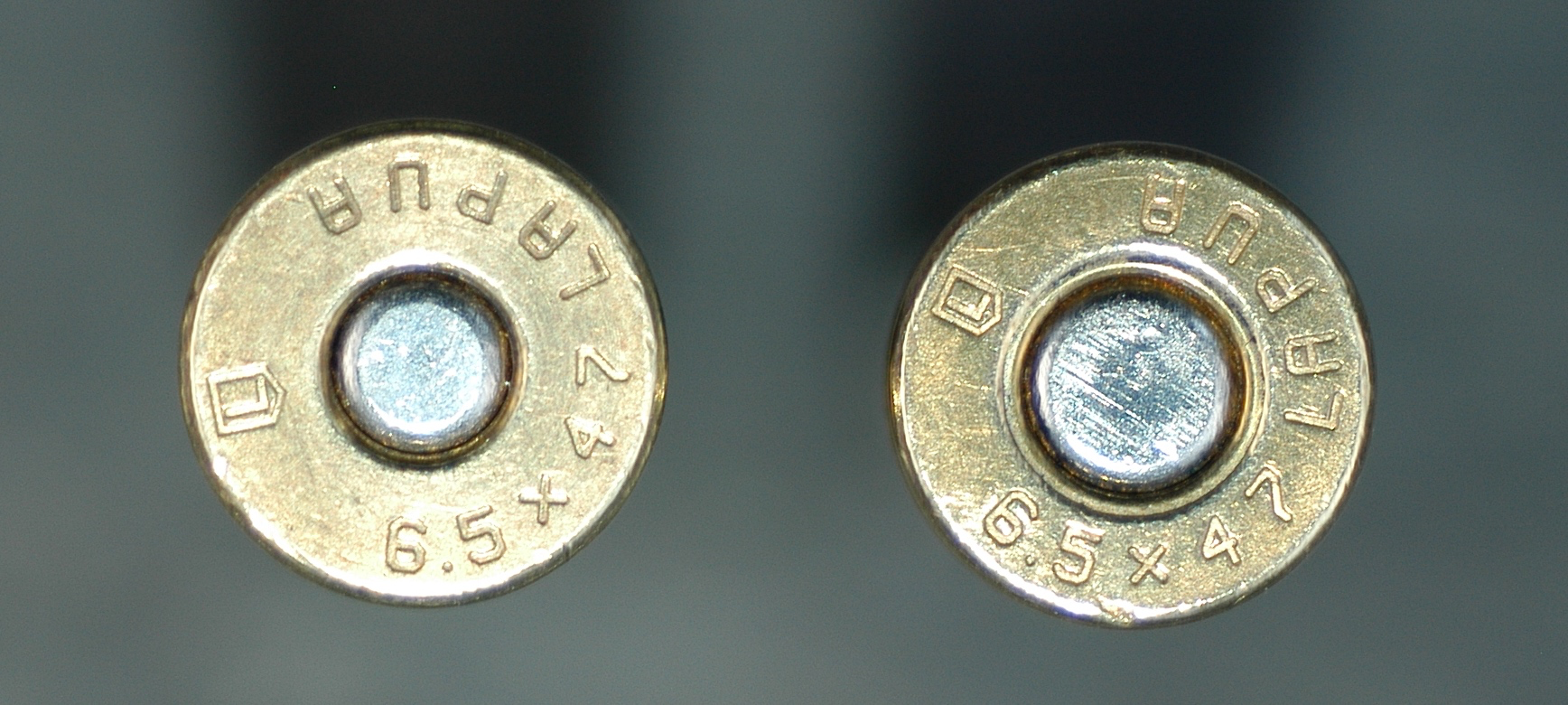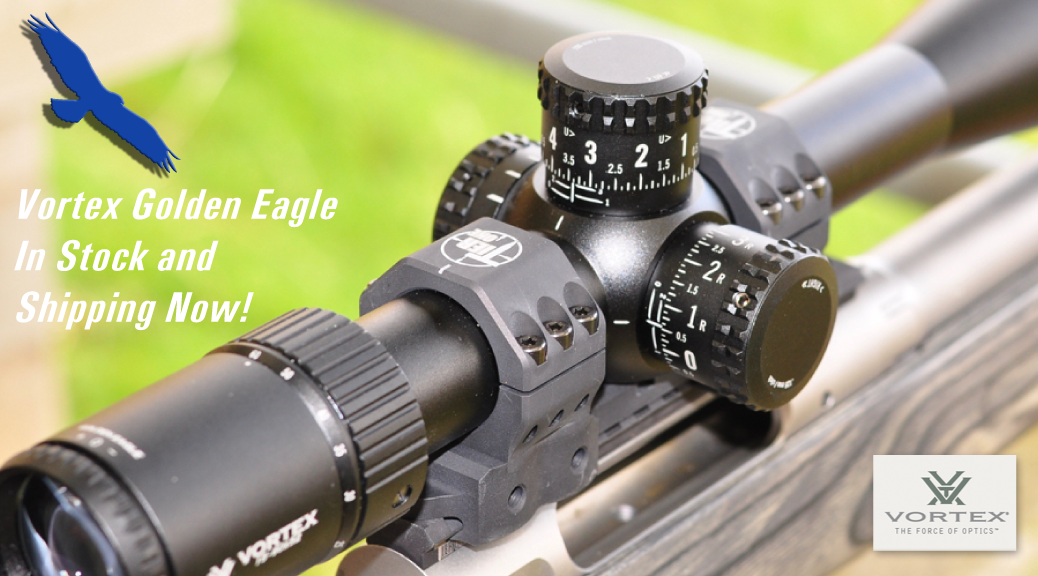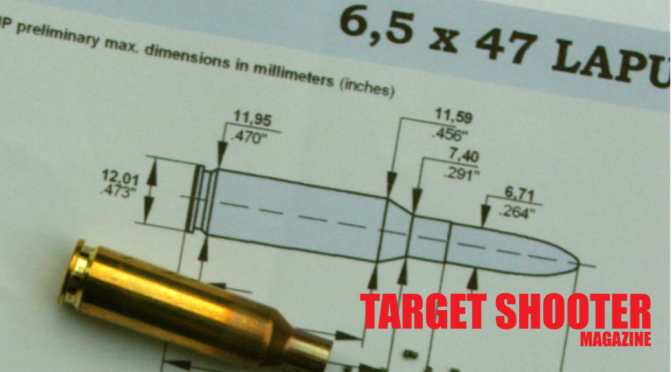
The mid-size 6.5mm Trio. Left to right: 6.5X47mm Lapua; 260 Remington; 6.5mm Hornady Creedmoor
Somewhat younger and smaller than my previous subject the 260 Rem, we have the giant-killing 6.5x47mm Lapua with a 4mm shorter case, nominally 47mm/1.85” length (Figure 1). When I used the cartridge, my rifle’s chamber produced a fireformed hull that held 48.8gn of water, 11.4% less than equivalent Lapua 260 cases. The internal ballistics rule of thumb is to divide the percentage capacity change by four to get the percentage MV change, all other things (bullet, barrel length, peak pressure) being the same. So, the smaller Lapua design should produce 2.5-3% lower velocities than the 260, some 70-85 fps in a 2,800 fps load.
However, offsetting the capacity reduction, CIP allows an impressive 63,091 psi chamber pressure, and in real life their performance is close in most barrel lengths. Moreover, unlike much 260 Rem brass (and Hornady manufacture 6.5mm Creedmoor for that matter), you don’t have to restrict loads and pressures to something below that value to get more than a couple of firings out of cases. This round thrives on full pressures whilst much US sourced 260 and Creedmoor brass is best restricted to factory ammunition levels of 57-58,000 psi.

6.5x47mm Lapua
This is a strong design with little body taper and steep 30-deg angle shoulders. It has the longest neck of the trio at a shade under 0.3” – very useful when it comes to keeping the bullet shank/tail junction ‘pressure ring’ above the bottom of the case-neck. That 4mm case-length reduction is also significant as allied to the long neck, it reduces the amount of bullet protrusion into the combustion chamber reducing or eliminating potential competition with the powder-charge for interior space. As with the other two modern 6.5mm designs, it uses the standard 308 case-head/rim/extractor groove form but there is an important difference between it and its 260 Rem/6.5 Creedmoor rivals. They use standard large rifle primers alongside the common 2mm (0.080”) dia. flash-hole, whilst the 6.5x47L employs a small rifle primer allied to a 1.5mm (0.059”) flash-hole. In other words, it uses the tried and tested ignition arrangements of the world’s most successful small precision cartridges, the PPCs and BRs.

6.5x47mm with small primer/flash-hole is flanked by large primer 260 Rem and ‘conventional’ 6.5 Creedmoor
However ….. this exclusivity is about to evaporate as Lapua announced late last year it had started production of small rifle primed (SRP) 6.5mm Creedmoor brass for delivery in the early months of 2017. In this form the back end of the case is exactly as per the 6.5x47L and will presumably accept the same pressures, but you now get a longer, higher capacity body. (So, in practice we now have 6.5x47mm and 6.5x49mm Lapua cartridges, for handloaders at any rate, potentially diminishing the first named’s advantages).

The rare large primer 6.5×47 brass
Returning to the 6.5x47L, Lapua apparently tried both forms as some prototype large primer brass was produced before the design was fixed. The company’s engineers must have concluded that the SRP form is superior in the cartridge’s intended match-shooting role. The benefits of the small primer/flash-hole are better ignition control reducing velocity variations, possibly slower pressure build-up, and a very strong case-head/web. There are possible downsides to this arrangement. One pitfall is primers ‘cratering’ or ‘blanking’ with loads that are well short of maximum pressures in rifles whose actions have large diameter firing-pins with a slack fit in the bolt-face aperture. This is a problem encountered by some individual factory actions with limited production precision models rarely affected. Small rifle magnum/BR primers should be used for both cup strength and energy as this size is getting close to its limits igniting 40 or so grains weight of powder charge. There won’t be any problems with easily ignited extruded propellants but the set-up might be unreliable with some ball powders especially in very cold conditions.

6.5X47 Lapua cases with cratered and blanked Rem 7½BR primers at low pressures due to firing pin issues
COALs
The nominal maximum COAL for the cartridge is 71mm/2.795” (although since it’s mostly used in custom builds, owners have their rifles throated to suit whatever bullet they intend to use). That length sees 2.795” – 1.850” = 0.945” of bullet sitting ahead of the case-mouth and for a 140gn Berger Target Hybrid measuring 1.426” (the longest 6.5mm bullet generally available), the rear 0.481” is inside the case of which 0.182” will be below the neck/shoulder junction but this is tapered tail not parallel shank. This is actually the optimum bullet seating position. In practice, if you just go to your gunsmith and ask for a 6.5x47L barrel to be fitted, it’ll most likely be throated shorter with just over 100 thou’ of freebore – my example was pretty typical allowing COALs around 2.650” and like most such chambers suits 120-130gn weight bullets best, the 123gn Scenar optimally seated at this COAL.

123gn Lapua Scenar ‘pressure ring’ and bullet base positions at 2.650” COAL (left); 140gn Berger VLD at 2.795” COAL (right)
Weights
Given the cartridge’s clear superiority over the 260 Rem in this matter of bullet length to COAL compatibility, that raises the question of ideal bullet weight(s) for this small cartridge. Experience shows the ‘47L offers stunning performance with 120-130gn bullets and their aerodynamic efficiency is such that some of these apparently lightweight projectiles provide remarkable long-range external ballistics. So it seems the majority of 6.547L users apparently favour 123s for mid and long-range match shooting, some 130gn bullets. I also took this view that the cartridge is optimised with these bullet weights during my ownership. I also know a couple of individuals who had their first ‘47L barrels throated for 140s but reverted to a shorter freebore subsequently in the light of experience when barrel number 2 was fitted.
The argument for lighter bullets is therefore proven? Not at all, as there are some very successful ‘47L shooters around whose chambers are throated for longer 130-142gn projectiles. Team Lapua USA member Erik Cortina is one of the best known and successful F-Class proponents of the 6.5×47 loaded with ‘heavies’ and I can think of a couple of like minded individuals in the UK F Class scene who do well too.
It may be that the mid-weight 130gn provides the best of all possible worlds but testing this hypothesis was severely hampered until recently by its being limited to single models from Berger, Norma and JLK – all very aggressively styled VLDs. The Berger alone has been available in the UK with any regularity and I couldn’t get it to perform in three different 6.5s. Fortunately, with new Berger AR-Hybrid Tactical OTM and Sierra TMK models now available, both with jump tolerant ogives, the prospects for this weight have now improved markedly.
Pic 05 130gn bullets, left to right: Berger AR-Hybrid Tactical OTM, Sierra TMK, Berger VLD
Giant Killer?
Look at some online forums and if you believe its fans’ wilder assertions, this modern ‘David’ will knock the stuffing out of its bigger and older competitors, the 260 and 6.5x55mm SKAN. According to some supporters, it will even match 6.5-284 ‘Goliath’ velocities. For starters, forget 6.5-284 performance – you can’t persuade a cartridge burning 37-42gn of powder to match the MVs and MEs of one that burns an additional 12gn or so even when the latter suffers a modest pressure penalty.
Sticking to a 26-inch barrel rifle, with my chamber (48.8gn fired case water capacity and 2.650-inch COAL with the 123gn Lapua Scenar), QuickLOAD predicts MVs around 50 fps lower than the same bullet in my 260 Rem set-up when a 3,000 psi ‘pressure discount’ is applied to both numbers to provide some safety margin (ie 57,000 psi for the 260 and 60,000 for the ’47 Lapua.) In the case of the 6.5x55mm SKAN, this cartridge is predicted to give similar, on balance a little higher, MVs than the ‘47L with 140s if it is restricted to 53,000 psi – again a discount on the CIP PMax value, but in this case I’d say unnecessary in a modern rifle with Lapua brass.

6.5X47L, 6.5X55, and 6.5-284 Norma. The larger pair should outperform the small Lapua number
Increasing 6.5x47L loads/pressures to the maximum allowed 63,091 psi sees a few very hot powders potentially break 2900 fps and a number of single-based types should move into the low end of the 2800-2850 fps bracket with a 140gn Berger, only Reload Swiss RS62 apparently capable of bettering the upper figure. I’ve italicised ‘potentially’ and ‘should’ because these ‘maybe velocities’ are based on QuickLOAD simulations and, in my experience, pressure signs and problems often arise in the smaller 6.5s at lower charge weights than the program predicts.
With many 6.5×47 load combinations seeing the powder charge consumed when the bullet is somewhere between 12 and 15-inches down the barrel, it is a very efficient design in short foxing and tactical rigs. With the near universal move to sound moderators among British sporting shooters usually allied to 14-18 inch barrel lengths, the cartridge is an excellent choice for such rifles. Even so, I have seen MV claims posted on forums for 123s and the 130gn Berger VLD in these rigs that are difficult to swallow. Either their owners have very ‘optimistic’ chronographs, or (and this is what worries me) some people are loading this cartridge to scary pressures. ‘Scary’ as in what? ‘Scary’ as in proof load plus.
(Interestingly, Hodgdon has recently added the cartridge to its interactive online Reloading Data Center and despite using a 30-inch barrel, only one powder out of the eleven Hodgdon/IMR grades with these pressure tested loads betters 2900 fps with the 123gn AMAX and none of the seven powders listed achieves 2800 fps with the 140gn Berger VLD. Far too cautious? Maybe …!)
Hobson’s Choice
So far as factory ammo goes, it’s a choice of Lapua or … apparently Lapua, nobody else loading it, not even the American specialists. When you need new unprimed brass, you have the same choice of one, so it’s as well that Lapua cases are really superb and in the UK at least usually readily available. Should supplies ever dry up 22-250 or 6.5mm Creedmoor brass could be re-formed but the new Lapua version of the Creedmoor aside, this would see the use of the weaker large primer case-head and loads/pressures would have to be restricted. Although expensive at over £1 per case, their life expectancy is such that the whole-life cost will likely be lower than that of equivalent US manufactured components for the 260 and Creedmoor.

Lapua 6.5×47 and 22-250 cases
Norma v Lapua
Going back to the cartridge’s introduction in 2005, its designers didn’t intend it to be a 1000 yard performer. Lapua worked closely with Swiss match rifle specialist Grunig & Elmiger during the cartridge’s development to produce a combination that would be a winner in 300 metre CISM/ISSF competition. I’m sure that an important motivation was to see a Lapua name design replacing that of the 6mm BR Norma as the discipline’s default cartridge. Lapua already had the marketing benefits of many top competitors firing its loadings of the ‘Six-BR’ but I’m sure that word took some of the gloss off the achievement. The 6.5x47mm Lapua was designed to match the 6BR’s precision, better its ballistics and offer improved barrel-life (important in this high consumption discipline) at the cost of heavier recoil.
Whilst these three-position disciplines have modest followings in the UK and the Americas, they are huge in Scandinavia and northern continental Europe, attracting high levels of interest and corporate sponsorship. Anyway, for whatever reason, few ISSF competitors switched to the 6.5x47L and the 6BR remains king there. Fortunately for Lapua, its 6.5 found plenty of other roles in field and target shooting.

300 metre contenders – 6mm BR Norma v 6.5x47mm Lapua. The BR remains most competitors’ choice
Mild
What does Lapua load its factory ammunition to?
Product # Bullet MV (fps) ME (ft/lb)
4316017 120gn Scenar-L GB547 2772 2053
4316011 123gn Scenar GB489 2790 2134
4316016 136gn Scenar-L GB546 2625 2077
4316012 139gn Scenar GB458 2690 2231
N316301 140gn Naturalis 2592 2094
As this ammunition will almost certainly be loaded with sister company Vihtavuori propellants, a look at that company’s load data plus some more QuickLOAD time suggests they’re loaded to 50-55,000 psi, therefore very mild. This performance ties in with the manufacturer’s 300-metre thinking and the desire to maximise barrel life. With its match origins there are four HPBT Scenar loadings, but Lapua has also included a single expanding bullet sporting option in the range with the 140gn mono-metal ‘Naturalis’ bullet. If you must use ‘factory’ expect to pay nearly £4 per bang for these Lapua products.
Custom Only?
It’s not just ammunition – much to my surprise, there is some difficulty in finding any rifle manufacturer which offers 6.5x47L as a standard chambering. There are a few European makers including our own Accuracy International which list it as a special order option – actually AI doesn’t even do that, but periodically receives government orders for rifles in the calibre and procures extra chambered barrels alongside for those who fancy an alternative to 308 Win. The new Victrix Armaments F-Class rifle is offered in 6.5×47 Lapua as is one of its tactical models.
I found another Italian manufacturer, Sabatti (FIAS), which listed the cartridge in one of its tactical rifles but this version didn’t appear to be imported to the UK. However, a new model, the STR has recently been launched here, challenging the Ruger Precision Rifle. This £1700 ‘Blacktical’ rifle has a Victrix Armaments folding aluminium chassis stock with all the essential ‘tacticool’ bells and whistles and is listed in 6.5x47L, 6.5 Creedmoor and 308. Finally, Blaser lists a sporting weight tube in the chambering for its R8 models. This seems to be the sole large scale manufacturer who has adopted the cartridge but it is in a different position from most rifle manufacturers. Blaser’s switch-barrel modular system obviously facilitates offering a wider range of chamberings – if one doesn’t sell, it’s a few hundred barrels sitting in store, not complete rifles.

The Sabatti STR is listed in 308 Win, 6.5 Creedmoor, and 6.5X47L chamberings
Powders
So far as loads go, the ‘47L’s smaller case makes it a little different to the others. The 260 and Creedmoor thrive on slower burning powders in the 4350s/RS62/N160/Ramshot Hunter bracket, even a bit slower burning with H4831sc first choice under 140s for some top American 260 shooters. The 6.5x47L seems to be on an internal ballistics watershed in that slightly faster burners – H. VarGet, Viht N140, IMR-4895, Re15, RS52 – become viable.
Speak to a group of users who load 123s or 130s and you’ll likely find more using this group with VarGet the number one choice but there are some Alliant Reloder 15 and N140 fans too. Some rifles/barrels just don’t take to these powders though – my Stolle Atlas based BR/F-Class rifle wouldn’t produce a half decent group with any of them and needed something burning rather more slowly. H4350 and Viht N150 performed very well and I adopted the 123gn Scenar plus N150 as my standard match load for all distances.
Since then, Reload Swiss RS62 has arrived and I’m pretty sure it’s a viable contender for rifles like mine. (Before the barrel’s demise, I was able to test the faster burning ‘high-energy’ RS52 against its Hodgdon VarGet equivalent under the 123gn Scenar. It did well insofar as velocities and spreads were concerned, but produced no better groups). Reload Swiss 6.5x47L data is now available on www.propellants.co.uk with loads for the 123gn Scenar and 140gn Hornady AMAX. The other two cartridges aren’t covered as yet.
Note that RS62 is the relatively long-grain single-based grade with a burn-rate roughly matching that of the 4350s. It shouldn’t be confused with RS60, a short-cut ‘high-energy’ powder with a similar burning speed, which is marketed as Alliant Reloder 17 outside of Europe. RS60/RL17 can provide startling MVs in the cartridge, but with a risk of temperature sensitivity and accelerated barrel wear.

Darrell Evans’ record holding 6.5×47 AI rifle in precision shooting mode – a true all-rounder, this rifle shoots paper, pests, and deer with equal efficiency.
Part 5 will look at the 6.5mm Hornady Creedmoor.


